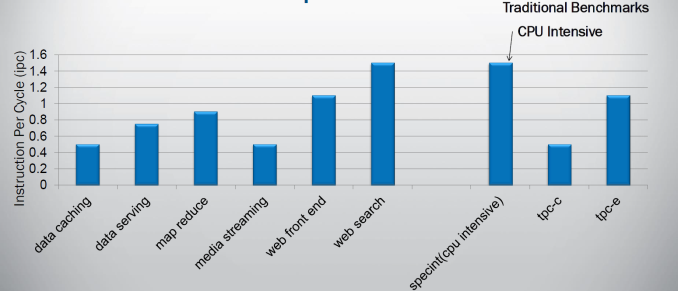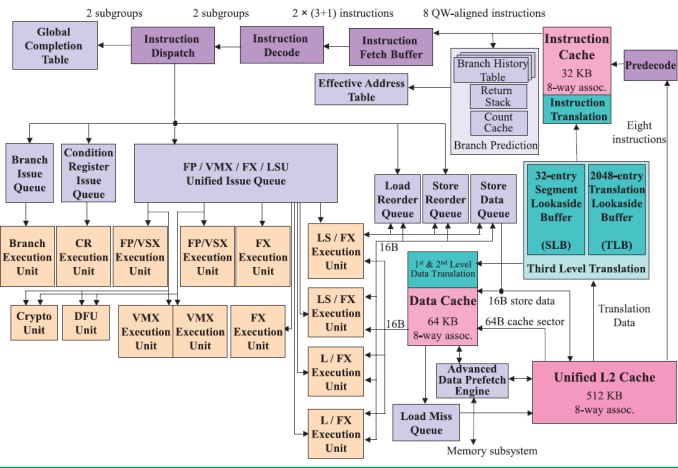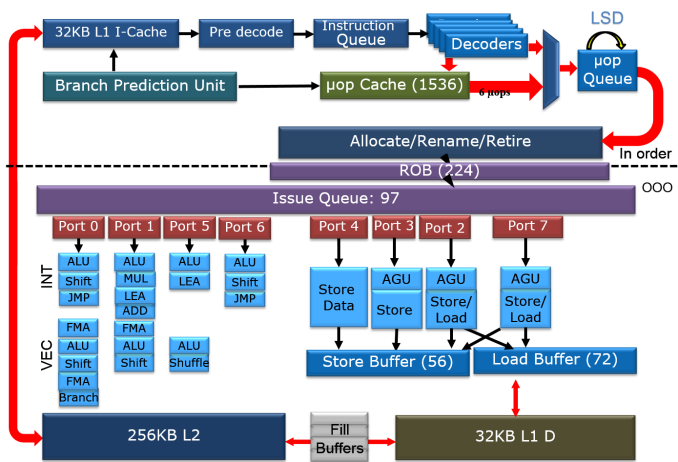Assessing IBM's POWER8, Part 1: A Low Level Look at Little Endian
by Johan De Gelas on July 21, 2016 8:45 AM ESTInside the Beast(s)
When the POWER8 was first launched, the specs were mind boggling. The processor could decode up to 8 instructions, issue 8 instructions, and execute up to 10 and all this at clockspeed up to 4.5 GHz. The POWER8 is thus an 8-way superscalar out of order processor. Now consider that
- The complexity of an architecture generally scales quadratically with the number of "ways" (hardware parallelism)
- Intel's most advanced architecture today - Skylake - is 5-way
and you know this is a bold move. If you superficially look at what kind of parallelism can be found in software, it starts to look like a suicidal move. Indeed on average, most modern CPU compute on average 2 instructions per clockcycle when running spam filtering (perlbench), video encoding (h264.ref) and protein sequence analyses (hmmer). Those are the SPEC CPU2006 integer benchmarks with the highest Instruction Per Clockcycle (IPC) rate. Server workloads are much worse: IPC of 0.8 and less are not an exception.
It is clear that simply widening a design will not bring good results, so IBM chose to run up to 8 threads simultaneously on their core. But running lots of threads is not without risk: you can end up with a throughput processor which delivers very poor performance in a wide range of applications that need that single threaded speed from time to time.
The picture below shows the wide superscalar architecture of the IBM POWER8. The image is taken from the white paper "IBM POWER8 processor core architecture", written by B. Shinharoy and many others.
The POWER8+ will have very similar microarchitecture. Since it might have to face a Skylake based Xeon, we thought it would be interesting to compare the POWER8 with both Haswell/Broadwell as Skylake.
The second picture is a very simplified architecture plan that we adapted from an older Intel Powerpoint presentation about the Haswell architecture, to show the current Skylake architecture. The adaptations were based on the latest Intel optimization manuals. The Intel diagram is much simpler than the POWER8's but that is simply because I was not as diligent as the people at IBM.
It is above our heads to compare the different branch prediction systems, but both Intel and IBM combine several different branch predictors to choose a branch. Both make use of a very large (16 K entries) global branch history table. Both processors scan 32 bytes in advance for branches. In case of IBM this is exactly 8 instructions. In case of Intel this is twice as much as it can fetch in one cycle (16 Bytes).
On the POWER8, data is fetched from the L2-cache and then predecoded into the L1-cache. Predecoding includes adding branch, exception, and grouping. This makes sure that predecoding is out the way before the actual computing ("Von Neuman Cycle") starts.
In Intel Haswell/Skylake, instructions are only predecoded after they are fetched. Predecoding performs macro-op fusion: fusing two x86 instructions together to save decode bandwidth. Intel's Skylake has 5 decoders and up to 5 µop instructions are sent down the pipelines. The current Xeon based upon Broadwell has 4 decoders and is limited to 4 instructions per clock. Those decoded instructions are sent into a µ-op cache, which can contain up to 1536 instructions (8-way), about 100 bits wide. The hitrate of the µop cache is estimated at 80-90% and up to 6 µops can be dispatched in that case. So in some situations, Skylake can run 6 instructions in parallel but as far as we understand it cannot sustain it all the time. Haswell/Broadwell are limited to 4. The µop cache can - most of the time - reduce the branch misprediction penalty from 19 to 14.
Back to the POWER8. Eight instructions are sent to the IBM POWER8 fetch buffer, where up 128 instructions can be held for two thread(s). A single thread can only use half of that buffer (64 instructions). This method of allocation gives each of two threads as much resources as one (i.e. no sharing), which is one of the key design philosophies for the POWER8 architecture.
Just like in the x86 world, the decoding unit breaks down the more complex RISC instructions into simpler internal instructions. Just like any modern Intel CPU, the opposite is also possible: the POWER8 is capable of fusing some combinations of 2 adjacent instructions into one instruction. Saving internal bandwidth and eliminating branches is one of the way this kind of fusion increases performances.
Contrary to the Intel's unified queue, the IBM POWER has 3 different issue queues: branch, condition register, and the "Load/Store/FP/Integer" queue. The first two can issue one instruction per clock, the latter can send off 8 instructions, for a combined total of 10 instructions per cycle. Intel's Haswell-Skylake cores can issue 8 µops per cycle. So both the POWER8 and Intel CPU have more than ample issue and execution resources for single threaded code. More than one thread is needed to really make use of all those resources.
Notice the difference in focus though. The Intel CPU has half of the load units (2), but each unit has twice the bandwidth (256 bit/cycle). The POWER8 has twice the amount of load units (4), but less bandwidth per unit (128 bit per cycle). Intel went for high AVX (HPC) performance, IBM's focus was on feeding 2 to 8 server threads. Just like the Intel units, the LSUs have Address Generation Units (AGUs). But contrary to Intel, the LSUs are also capable of doing simple integer calculations. That kind of massive integer crunching power would be a total waste on the Intel chip, but it is necessary if you want to run 8 threads on one core.













124 Comments
View All Comments
abufrejoval - Thursday, August 4, 2016 - link
I believe "heavily threaded" is somewhat imprecise here: Knights Landing (KNL) is really more about vectorized workloads, or one very loopy and computationally expensive problem, which has been partitioned into lots of chunks, but has high locality. Same code, related data, far more computational throughput than data flowthrough.Power8 will do better on such workloads than perhaps Intel, but never as good as a GPU or KNL.
However it does evidently better per core on highly threaded workloads, where lots of execution threads share the same code but distinct or less related datasets, less scientific and more commercial workloads, more data flowing through.
Funnily KNL might even do well there, beating its Xeon-D sibling in every benchmark, even in terms of energy efficience.
But I'm afraid that's because most of the KNL surface area would remain dark on such workload while the invests would burn through any budget.
KNL is an odd beast designed for a rather specific job and only earn its money there, even if you can run Minecraft or Office on it.
Kevin G - Friday, July 22, 2016 - link
I do think comparison with Xeon Phi is fair since it can run/boot itself now with Knight's Landing. Software parity with the normal x86 ecosystem is now there so it can run off the shelf binaries.I am very curious how well such a dense number of cores perform for workloads that don't need high single threaded performance.
Another interest factor would be memory bandwidth performance as Xeon Phi has plenty. The HMC only further enhances that metric and worth exploring it as both a cache and main memory region for benchmarks.
Ratman6161 - Thursday, July 21, 2016 - link
Will you be addressing virtualization in a future article. I ask this because you are saying the lower cost Power8 systems are intended to compete with the Dell's, HP's, Lenovo etc x86 servers. But these days, a very high percentage of x86 work loads are virutalized either on VMWare or competing products. In 2009 Gartner had it at about 50% and by 2014 it was at 70%. I didn't find a number for '15 or '16 but I expect the percentage would have continued to rise. So if they want to take the place of x86 boxes, they have to be able to do the tasks those boxes do...which tends to largely be to run virtual machines that do the actual workloads.And, what about all the x86 boxes running Windows Server or more commonly Windows Server Virtual machines? Windows Server shops aren't likely to ditch windows in favor of Linux solely for the privilege of running on Power8?
One last thing to consider regarding price. These days we can buy quite robust Intel based server for around $10K. So, supposing I can buy a Power8 system for about the same price? Essentially the hardware has gotten so cheap compared to the licensing and support costs for the software we are running that its a drop in the bucket. If we needed 10 Intel servers or 6 Power 8's to do the same job (assuming the Power8's could run all our VM's), the Power8's could come out lower priced hardware wise, but the difference is, as I said, a drop in the bucket in the overall scheme of things. Performance wise, with the x86 boxes, you just throw more cores at it.
aryonoco - Friday, July 22, 2016 - link
KVM works well on POWER.No idea about proprietary things like VMWare. But that would be up to them to port.
Ratman6161 - Friday, July 22, 2016 - link
Near as I can tell, there is a PowerKVM that runs on Power 8 but that doesn't allow you to run Windows Server VM's - seems to support only Linux guests.Zetbo - Saturday, July 23, 2016 - link
Windows does not support POWER, so there is no point of using POWER if you need Windows!utroz - Thursday, July 21, 2016 - link
AMD should have used IBM's 22nm SOI to make cpu's so that they would not have been totally dead in the performance and server cpu market for years. GF now owns this process as they "bought" IBM's fabs and tech. I think that 22nm SOI might be better for high speed cpu's than the 14nm LPP FinFet that AMD is using for ZEN at the cost of die size.amagriva - Thursday, July 21, 2016 - link
How much you payed your cristal ball?spikebike - Thursday, July 21, 2016 - link
So a single socket Power8 is somewhat faster than the intel chip. But is being compared in a single socket configuration where the intel is designed for a two socket. Unless the power8 is cheaper than an intel dual socket seems most fare to compare both CPU as they are designed to be used.SarahKerrigan - Friday, July 22, 2016 - link
Power is designed for systems up to 16 sockets (IBM E880.) One socket is just the entry point.